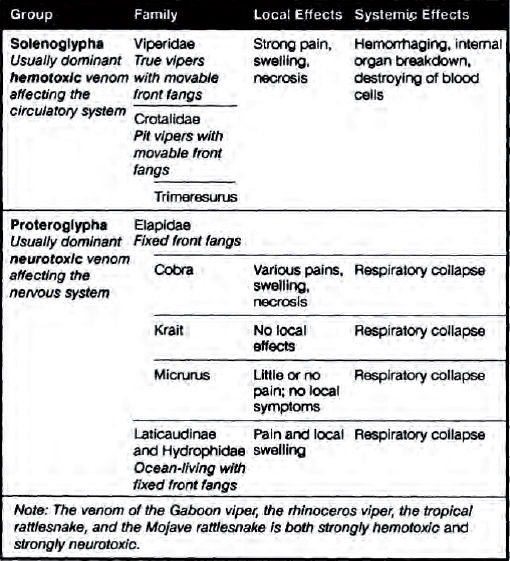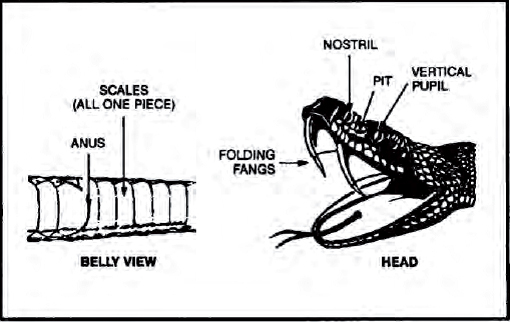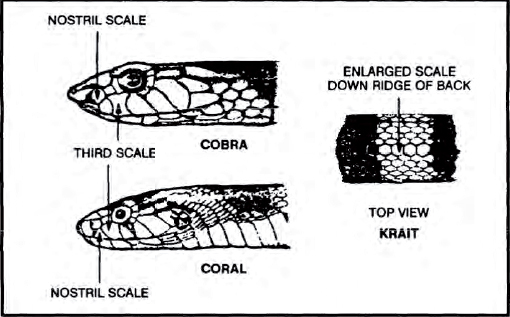• Don’t pick up any snake unless you are absolutely positive it is not venomous.
• Don’t pick up freshly killed snakes without first severing the head.
• The nervous system may still be active and a dead snake can deliver a bite.
SNAKE GROUPS
Snakes dangerous to man usually fall into two groups: proteroglypha and solenoglypha. Their fangs and their venom best describe these two groups (Table 4-1).
Fangs
The proteroglypha have, in front of the upper jaw and preceding the ordinary teeth, permanently erect fangs. These fangs are called fixed fangs.
Table 4-1: Snake group characteristics
Group
Fang Type
Venom Type
Proteroglypha
Fixed
Usually dominant neurotoxic
Solenoglypha
Folded
Usually dominant hemotoxic
The solenoglypha have erectile fangs; that is, fangs they can raise to an erect position. These fangs are called folded fangs.
Venom
The fixed-fang snakes (proteroglypha) usually have neurotoxic venoms. These venoms affect the nervous system, making the victim unable to breathe.
The folded-fang snakes (solenoglypha) usually have hemotoxic venoms, These venoms affect the circulatory system, destroying blood cells, damaging skin tissues, and causing internal hemorrhaging.
Remember, however, that most poisonous snakes have both neurotoxic and hemotoxic venom. Usually one type of venom in the snake is dominant and the other is weak.
Poisonous Versus Nonpoisonous Snakes
No single characteristic distinguishes a poisonous snake from a harmless one except the presence of poison fangs and glands. Only in dead specimens can you determine the presence of these fangs and glands without danger.
DESCRIPTIONS OF POISONOUS SNAKES
There are many different poisonous snakes throughout the world. It is unlikely you will see many except in a zoo. This manual describes only a few poisonous snakes. You should, however, be able to spot a poisonous snake if you–
• Learn about the two groups of snakes and the families in which they fall (Table 4-2).
• Examine the pictures and read the descriptions of snakes in this appendix.
Viperidae
The viperidae or true vipers usually have thick bodies and heads that are much wider than their necks (Figure 4-1). However, there are many different sizes, markings, and colorations.
This snake group has developed a highly sophisticated means for delivering venom. They have long, hollow fangs that perform like hypodermic needles. They deliver their venom deep into the wound.
The fangs of this group of snakes are movable. These snakes fold their fangs into the roof of their mouths. When they strike, their fangs come forward, stabbing the victim. The snake controls the movement of its fangs; fang movement is not automatic. The venom is usually hemotoxic. There are, however, several species that have large quantities of neurotoxic elements, thus making them even more dangerous. The vipers are responsible for many human fatalities around the world.
Table 4-2: Clinical effects of snake bites

Crotalidae
The crotalids, or pit vipers (Figure 4-2), may be either slender or thick-bodied. Their heads are usually much wider than their necks. These snakes take their name from the deep pit located between the eye and the nostril. They are commonly brown with dark blotches, though some kinds are green.

Figure 4-1: Positive identification of vipers

Figure 4-2: Positive identification of pit vipers
Rattlesnakes, copperheads, cottonmouths, and several species of dangerous snakes from Central and South America, Asia, China, and India fall into the pit viper group. The pit is a highly sensitive organ capable of picking up the slightest temperature variance. Most pit vipers are nocturnal. They hunt for food at night with the aid of these specialized pits that let them locate prey in total darkness. Rattlesnakes are the only pit vipers that possess a rattle at the tip of the tail.
India has about 12 species of these snakes. You find them in trees or on the ground in all types of terrain. The tree snakes are slender; the ground snakes are heavy-bodied. All are dangerous.
China has a pit viper similar to the cottonmouth found in North America. You find it in the rocky areas of the remote mountains of South China. It reaches a length of 1.4 meters but is not vicious unless irritated. You can also find a small pit viper, about 45 centimeters long, on the plains of eastern China. It is too small to be dangerous to a man wearing shoes.
There are about 27 species of rattlesnakes in the United States and Mexico. They vary in color and may or may not have spots or blotches. Some are small while others, such as the diamondbacks, may grow to 2.5 meters long.
There are five kinds of rattlesnakes in Central and South America, but only the tropical rattlesnake is widely distributed. The rattle on the tip of the tail is sufficient identification for a rattlesnake.
Most will try to escape without a fight when approached, but there is always a chance one will strike at a passerby. They do not always give a warning; they may strike first and rattle afterwards or not at all.
The genus Trimeresurus is a subgroup of the crotalidae. These are Asian pit vipers. These pit vipers are normally tree-loving snakes with a few species living on the ground. They basically have the same characteristics of the crotalidae–slender build and very dangerous. Their bites usually are on the upper extremities–head, neck, and shoulders. Their venom is largely hemotoxic.
Elapidae
A group of highly dangerous snakes with powerful neurotoxic venom that affects the nervous system, causing respiratory paralysis. Included in this family are coral snakes, cobras, mambas, and all the Australian venomous snakes. The coral snake is small and has caused human fatalities. The Australian death adder, tiger, taipan, and king brown snakes are among the most venomous in the world, causing many human fatalities.

Figure 4-3: Positive identification of cobras, kraits, and coral snakes
Only by examining a dead snake can you positively determine if it is a cobra or a near relative (Figure 4-3). On cobras, kraits, and coral snakes, the third scale on the upper lip touches both the nostril scale and the eye. The krait also has a row of enlarged scales down its ridged back.
You can find the cobras of Africa and the Near East in almost any habitat. One kind may live in or near water, another in trees. Some are aggressive and savage. The distance a cobra can strike in a forward direction is equal to the distance its head is raised above the ground. Some cobras, however, can spit venom a distance of 3 to 3.5 meters. This venom is harmless unless it gets into your eyes; then it may cause blindness if not washed out immediately. Poking around in holes and rock piles is dangerous because of the chance of encountering a spitting cobra.
Laticaudinae and Hydrophidae
A subfamily of elapidae, these snakes are specialized in that they found a better environment in the oceans. Why they are in the oceans is not clear to science.
Sea snakes differ in appearance from other snakes in that they have an oarlike tail to aid in swimming. Some species of sea snakes have venom several times more toxic than the cobra’s. Because of their marine environment, sea snakes seldom come in contact with humans. The exceptions are fishermen who capture these dangerous snakes in fish nets and scuba divers who swim in waters where sea snakes are found.